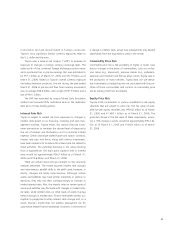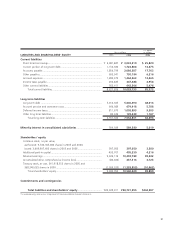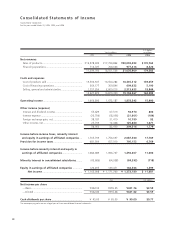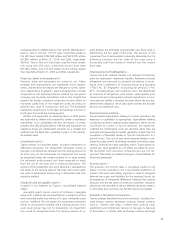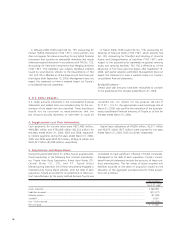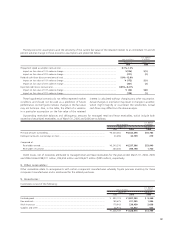Toyota 2006 Annual Report Download - page 95
Download and view the complete annual report
Please find page 95 of the 2006 Toyota annual report below. You can navigate through the pages in the report by either clicking on the pages listed below, or by using the keyword search tool below to find specific information within the annual report.93
companies which is determined on the “specific identification”
basis or “last-in, first-out” (“LIFO”) basis. Inventories valued on
the LIFO basis totaled ¥233,440 million and ¥329,205 million
($2,802 million) at March 31, 2005 and 2006, respectively.
Had the “first-in, first-out” basis been used for those compa-
nies using the LIFO basis, inventories would have been
¥31,894 million and ¥17,070 million ($145 million) higher
than reported at March 31, 2005 and 2006, respectively.
Property, plant and equipment—
Property, plant and equipment are stated at cost. Major
renewals and improvements are capitalized; minor replace-
ments, maintenance and repairs are charged to current opera-
tions. Depreciation of property, plant and equipment is mainly
computed on the declining-balance method for the parent
company and Japanese subsidiaries and on the straight-line
method for foreign subsidiary companies at rates based on
estimated useful lives of the respective assets according to
general class, type of construction and use. The estimated
useful lives range from 2 to 65 years for buildings and from 2
to 20 years for machinery and equipment.
Vehicles and equipment on operating leases to third parties
are originated by dealers and acquired by certain consolidated
subsidiaries. Such subsidiaries are also the lessors of certain
property that they acquire directly. Vehicles and equipment on
operating leases are depreciated primarily on a straight-line
method over the lease term, generally 5 years, to the estimat-
ed residual value.
Long-lived assets—
Toyota reviews its long-lived assets, including investments in
affiliated companies, for impairment whenever events or
changes in circumstances indicate that the carrying amount of
an asset may not be recoverable. An impairment loss would
be recognized when the carrying amount of an asset exceeds
the estimated undiscounted cash flows expected to result
from the use of the asset and its eventual disposition. The
amount of the impairment loss to be recorded is calculated by
the excess of the carrying value of the asset over its fair value.
Fair value is determined mainly using a discounted cash flow
valuation method.
Goodwill and intangible assets—
Goodwill is not material to Toyota’s consolidated balance
sheets.
Intangible assets consist mainly of software. Intangible
assets with a definite life are amortized on a straight-line basis
with estimated useful lives mainly of 5 years. Intangible assets
with an indefinite life are tested for impairment whenever
events or circumstances indicate that a carrying amount of an
asset (asset group) may not be recoverable. An impairment
loss would be recognized when the carrying amount of an
asset exceeds the estimated undiscounted cash flows used in
determining the fair value of the asset. The amount of the
impairment loss to be recorded is generally determined by the
difference between the fair value of the asset using a
discounted cash flow valuation method and the current
book value.
Employee benefit obligations—
Toyota has both defined benefit and defined contribution
plans for employees’ retirement benefits. Retirement benefit
obligations are measured by actuarial calculations in accor-
dance with a Statement of Financial Accounting Standard
(“FAS”) No. 87 Employers’ accounting for pensions (“FAS
87”), “Accrued pension and severance costs” are determined
by amounts of obligations, plan assets, unrecognized prior
service costs and unrecognized actuarial gains/losses. A mini-
mum pension liability is recorded for plans where the accumu-
lated benefit obligation net of plan assets exceeds the accrued
pension and severance costs.
Environmental matters—
Environmental expenditures relating to current operations are
expensed or capitalized as appropriate. Expenditures relating
to existing conditions caused by past operations, which do not
contribute to current or future revenues, are expensed.
Liabilities for remediation costs are recorded when they are
probable and reasonably estimable, generally no later than the
completion of feasibility studies or Toyota’s commitment to a
plan of action. The cost of each environmental liability is esti-
mated by using current technology available and various engi-
neering, financial and legal specialists within Toyota based on
current law. Such liabilities do not reflect any offset for possi-
ble recoveries from insurance companies and are not dis-
counted. There were no material changes in these liabilities for
all periods presented.
Income taxes—
The provision for income taxes is computed based on the
pretax income included in the consolidated statement of
income. The asset and liability approach is used to recognize
deferred tax assets and liabilities for the expected future tax
consequences of temporary differences between the carrying
amounts and the tax bases of assets and liabilities. Valuation
allowances are recorded to reduce deferred tax assets when it
is more likely than not that a tax benefit will not be realized.
Derivative financial instruments—
Toyota employs derivative financial instruments, including for-
ward foreign currency exchange contracts, foreign currency
options, interest rate swaps, interest rate currency swap
agreements and interest rate options to manage its exposure
to fluctuations in interest rates and foreign currency exchange




